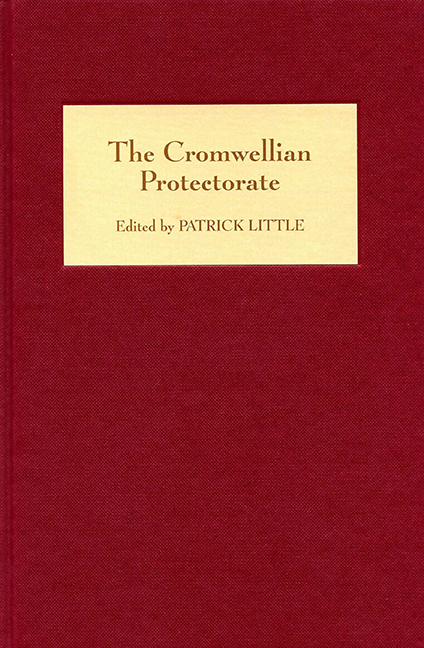Book contents
- Frontmatter
- Contents
- List of Illustrations
- Preface
- Notes on Contributors
- Abbreviations
- 1 Introduction
- 2 Oliver Cromwell and the Protectorate Parliaments
- 3 The Protector Humbled: Richard Cromwell and the Constitution
- 4 Cromwellian Style: The Architectural Trappings of the Protectorate Regime
- 5 Oliver Cromwell and the Council
- 6 ‘To Create a Little World out of Chaos’: The Protectoral Ordinances of 1653–1654 Reconsidered
- 7 The Irish and Scottish Councils and the Dislocation of the Protectoral Union
- 8 ‘This Murmuring and Unthankful Peevish Land’: Wales and the Protectorate
- 9 Cromwellian Towns in the Severn Basin: A Contribution to Cis-Atlantic History?
- 10 Policing the Cromwellian Church: The Activities of the County Ejection Committees, 1654–1659
- Index
10 - Policing the Cromwellian Church: The Activities of the County Ejection Committees, 1654–1659
Published online by Cambridge University Press: 24 October 2017
- Frontmatter
- Contents
- List of Illustrations
- Preface
- Notes on Contributors
- Abbreviations
- 1 Introduction
- 2 Oliver Cromwell and the Protectorate Parliaments
- 3 The Protector Humbled: Richard Cromwell and the Constitution
- 4 Cromwellian Style: The Architectural Trappings of the Protectorate Regime
- 5 Oliver Cromwell and the Council
- 6 ‘To Create a Little World out of Chaos’: The Protectoral Ordinances of 1653–1654 Reconsidered
- 7 The Irish and Scottish Councils and the Dislocation of the Protectoral Union
- 8 ‘This Murmuring and Unthankful Peevish Land’: Wales and the Protectorate
- 9 Cromwellian Towns in the Severn Basin: A Contribution to Cis-Atlantic History?
- 10 Policing the Cromwellian Church: The Activities of the County Ejection Committees, 1654–1659
- Index
Summary
One of the key concerns of the successive godly regimes that held power in England between 1642 and 1660 was to improve the moral and religious standards of the elect chosen nation they believed divine Providence had entrusted to their care. The nine thousand or so parochial ministers who were responsible for providing the day-to-day pastoral support for the population were perceived as a critical resource in this task, and strenuous efforts were made to ensure that they were both up to the task of moral reformation and religiously and politically ‘on message’. From the early 1640s onwards, a series of local investigations and purges was initiated, with the aim of removing from their cures all those who were considered either pastorally deficient or ideologically unsound, and replacing them with more acceptable men. While this campaign was intense in places, it was also somewhat uncoordinated and sporadic. In December 1642 the Long Parliament established a ‘committee for plundered ministers’ and entrusted it with the task of removing from the ministry all those who displayed Laudian or royalist sympathies. It subsequently bolstered this initiative by issuing additional specific commissions to local military commanders and parliamentary committeemen, such as Sir Thomas Fairfax in Yorkshire, Sir William Brereton in Cheshire, John Pyne in Somerset, and Thomas Cooke in Essex. These and other individuals pursued their local purges with enthusiasm, but the same commitment was not shown in all areas. In some parts of the country, either through the preoccupation or inefficiency of the local parliamentary authorities or the protection they received from powerful local patrons, numbers of suspect ministers remained in post. Thus, while overall somewhat over 20 per cent of the English clergy lost their livings during the course of the 1640s, the scale of ejections varied considerably across the country. The areas that saw the highest proportion were Kent, East Anglia, the east Midlands and the north-west, while in the west Midlands, the Severn valley and the southern Pennine region the level was below average. The highest rate of all occurred in London, where 36 per cent of ministers lost their positions.
Although by the early 1650s several thousand ministers had already been removed from the ministry, some of those in and around the new republican regime believed that a great many more ejections were needed if the work of moral regeneration was to achieve real and lasting results.
- Type
- Chapter
- Information
- The Cromwellian Protectorate , pp. 188 - 206Publisher: Boydell & BrewerPrint publication year: 2007

